Content for this page researched and created by Courtney Cambal
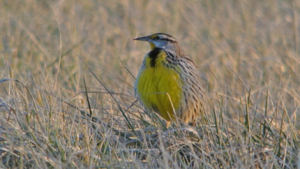
The Eastern Meadowlark (Sturnella magna) is a round, medium sized bird that lives in farm fields, grasslands, and pastures (Eastern Meadowlark Identification). Wetlands are also an occasional nesting site for Eastern Meadowlarks (Elliot). Eastern Meadowlarks have a primarily yellow front, with a black v shaped mark on their chests. They have a brown and white back and white tail feathers. Their colors fade in the winter (New Jersey Endangered and Threatened Species Field Guide). They have long spear shaped bills (Eastern Meadowlark Identification). Eastern Meadowlarks range from 7 to 10 inches long with a wingspan of 13 to 15 inches (Vuilleumier). Eastern Meadowlarks flight patterns are a combination of rapid fluttering and short glides (Eastern Meadowlark Identification).
The Sturnella magna can be found from eastern United States to southeastern Canada to northern parts of South America. Northern birds will migrate south for the winter (New Jersey Endangered and Threatened Species Field Guide). Females are slightly smaller than males. Despite the name lark, Eastern Meadowlarks are part of the family Icteridae, along with orioles and blackbirds (Wildscreen Achieve). The average life span for an Eastern Meadowlark is 5 to 9 years (Dexheimer).
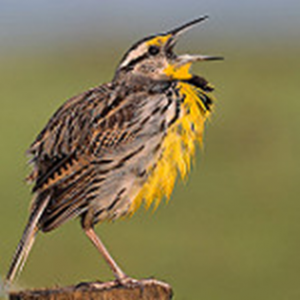
Eastern Meadowlarks have a variety of vocal communications, and each type serves a different purpose. They sing from perches such as logs and fence posts. The Sturnella magna call is a whistle (Pfannmuller). Eastern Meadowlarks will sing to attract mates and to warn others off their territory, the warning call sounding like a rattle (New Jersey Endangered and Threatened Species Field Guide). Nestling and fledged young will emit a high-pitched whistle, that serves as a location and begging note which enables parents to locate them (Dexheimer).
The Eastern Meadowlarks diet varies as the seasons change. In the spring, they feed on insects; specifically, wild grubs, caterpillars, and crickets (Eastern Meadowlark Life history). When summer comes, they still eat insects, but the insects primarily consist of grasshoppers and beetles. They then consume grains and seeds in the winter and sometimes, wild fruits (Vuilleumier). Eastern Meadowlarks feed in flocks in the winter (New Jersey Endangered and Threatened Species Field Guide) and prod the ground with their bills occasionally digging into the soil and then opening them to expose food (Eastern Meadowlark Life history).
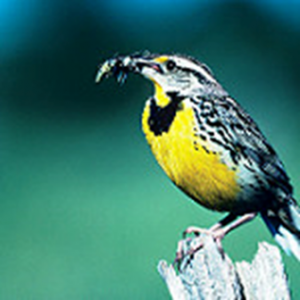
Breeding season occurs from late March to early August (Wildscreen Archive). Peak egg laying occurs from April to May (Roseberry). Males are polygamous (Bird Nature) and will mate with up to tree females at a time (Eastern Meadowlark Life history). Males arrive to the mating ground in early spring, and females arrive 2 to 3 weeks later. Courtship between pairs include areal chases and jump flights (Wildscreen Archive). Jump flights ensue when competing males jump in the air one after another with wings fluttering and feet dangling. Males will also show off to each other and to females by exposing their chest plumage. Singing is also used to attract mates and to establish territory (Eastern Meadowlark Life history). Mating territories are around 7 acres (New Jersey Endangered and Threatened Species Field Guide).

Eastern Meadowlark nests are cup shaped and woven with dead grasses, plant stems, and bark strips (Eastern Meadowlark Life history). Rush juncus, meadow fescue, cheat, and bluegrass are most commonly used in nest construction (Roseberry). The nests are roughly 6 to 9 inches wide and 2 to 3 inches deep. Some nests are more elaborate than others and are built with roofs and tunnels (Eastern Meadowlark Life history. Nests with roofs have been shown to have a higher success rate than those without (Roseberry). Nests are located in or on the ground (Eastern Meadowlark Identification). Two broods can be hatched in one season. The second brood will be laid two to three days after the first brood has fledged and dispersed (COSEWIC). The nest success rate grows as the season continues (Roseberry). Females lay 2 to 6 eggs in a clutch. An average of 4 to 18 eggs will be laid by one female per breeding season (Kershner). The eggs are incubated for 13 to 14 days (Wildscreen Archive). Eastern Meadowlark eggs are white with brown spots (Bird Nature). Nestlings have brown skin and closed eyes when they hatch (Eastern Meadowlark Life history). The nestlings fledge in 10 to 12 days but rely on their parents for food for another two weeks (Wildscreen Archive). Males will collect food and give it to the females so that they can feed their young (New Jersey Endangered and Threatened Species Field Guide).
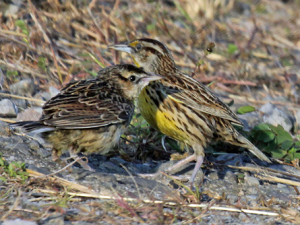
Although Eastern Meadowlarks are listed as a Least Concern species, their numbers are declining (Jaster). Threats include habitat loss, high rates of nest predation, pesticide use, and Cowbird nest parasitism. Eastern Meadowlark nests are vulnerable to predation by lizards, other bird species, and some mammals such as red foxes (COSEWIC). Cows are also predators of Sturnella magna. Their grazing destroys nests and removes eggs and nestlings from them (Nack). Predation from other species is most common in upland thickets than in wetlands or pastures (Picman). Animal predation is proven to be the number one reason why nests fail (Granfors).
Interactions with humans also affect Eastern Meadowlark behavior. Eastern Meadowlarks are very shy in nature and will abandon nests if they feel threatened. Nests are also susceptible to mowing and surface tilling. Both of these field management processes can kill adults and nestlings alike (Pfannmuller). New agricultural practices such as the replacement of forage crops with row crops influence nest sites. Another difficulty Eastern Meadowlarks face is climate change and fluctuating weather patterns such as droughts and snow storms (COSEWIC). Eastern Meadowlarks numbers were less abundant at sites following forest fires (Powell). Territory for the species is also disappearing due to forest growth from lack of forest fires (COSEWIC).
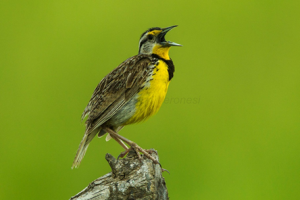
Conservation Programs have begun to help restore Eastern Meadowlark numbers. In fact, the ideal breeding habitat of CPR fields has allowed for higher succeeding nests (Ryan). It is now illegal to destroy nests and eggs (COSEWIC). Sturnella magna has become increasingly dependent on human altered grasslands for nesting (Warren). Maintaining complex systems of roadside vegetation might also be important for replenishing the Eastern Meadowlark population (Walk).
Another problem to the survival rate of Eastern Meadowlark species is Cowbird Nest parasitism. Sturnella magna serves as a host for brown-headed cowbirds. Female Cowbirds will hunt out females from other species who are laying eggs and damage or replace some of the eggs with ones of their own. The young cowbirds are the unknowingly raised by the Eastern Meadowlark parents. The Cowbird nestlings will hatch and grow faster than the Eastern Meadowlark nestlings, thus getting more attention and food from the Eastern Meadowlark parents (Nest Watch).
General References:
COSEWIC. 2011. COSEWIC assessment and status report Eastern Meadowlark Sturnella
Magna in Canada. Committee on the Status of Endangered Wildlife in Canada.
Ottawa. X + 40pp. (www.sararegestry.gc.ca/status/status_e.cfm).
Dexheimer, T. 2006. “Sturnella magna” (On-line), Animal Diversity Web. University of
“Eastern meadowlark fact file.” Wildscreen Archive. Ed. Wildscreen Archive, 2011. Web.
11 Sept. 2016.
“Eastern Meadowlark- Identification.” All About Birds. Cornell University, 2015. Web. 3
Sept. 2016.
“Eastern Meadowlark- Life History.” All About Birds. Cornell University, 2015. Web. 3 Sept.
2016.
Pfannmuller, A. Lee. “Eastern Meadowlark Minnesota Conservation Plan.” Minnesota Bird
Conservation, 2014. Web. 15 Sept. 2016.
“Eastern Meadowlark.” New Jersey Endangered and Threatened Species Field Guide.
Conserve Wildlife Foundation of New Jersey, 2016. Web. 20 Sept. 2016.
“Eastern Meadowlark Sturnella magna.” Bird Nature. Web. 18 Sept. 2016.
Jaster, Levi A, William E. Jensen and Wesley E. Lanyon. “Eastern Meadowlark (Sturnella
magna).” The Birds of North America Online. A. Poole. Cornell Lab of Ornithology,
2012. Web. 18 Sept. 2016.
Vuilleumier, François. Birds of North America. Dorling, Kindersley, 2009. Print.
Scientific References:
Elliott, Phillip F. “Cowbird Parasitism in the Kansas Tallgrass Prairie.” The Auk 95.1 (1978):
161-67. Web. 19 Sept. 2016.
Granfors, Diane A., Church Kevin E., and Smith Loren M. “Eastern Meadowlarks Nesting in
Rangelands and Conservation Reserve Program Fields in Kansas (Sturnella Magna
Anidando En Extensiones De Tierra Y Terrenos Del Programa De Reservas De
Conservación En Kansas).” Journal of Field Ornithology 67.2 (1996): 222-35. Web. 19
Sept. 2016.
Kershner, L Eric, Jeffery W. Walk, and Richard E. Warner. “Breeding-Season Decisions,
Renesting, and Annual Fecundity of Female Eastern Meadowlarks (Sturnella Magna)
in Southerneastern Illinois.” The Auk 121.3 (2004): 796-805. Web. 19 Sept. 2016.
Nack, LL. Jamie, and Christine A. Ribic. “Apparent Predation by Cattle at Grassland
Birdnests.” The Wilson Bulletin 128.2 (2005): 56-62. Web. 21 Sept.
2016.
Picman, Jaroslav. “Experimental Study of Predation on Eggs of Ground-Nesting Birds:
Effects of Habitat and Nest Distribution.” The Condor 90.1 (1988): 124-31. Web. 21
Sept. 2016.
Powell, F. L. A. Alexis. “Responses of breeding birds in tallgrass prairie to fire and cattle
grazing.” Journal of Field Ornithology 79.1 (2008): 41-52. Web. 21 Sept. 2016.
Roseberry, John L., and Klimstra W. D. “The Nesting Ecology and Reproductive
Performance of the Eastern Meadowlark.” The Wilson Bulletin 82.3 (1970): 243-67.
Web. 20 Sept. 2016.
Ryan, R. Mark. Burger, W. Loren. Kurzejeski. “The Impact of CPR on Avian Wildlife: A
Review.” Journal of Production Agriculture 11.1 (2013): 61-66. Web. 20 Sept. 2016.
Walk, W. Jeffery, Eric L. Kershner, Thomas J. Benson, and Richard E. Warner “Nesting
Success of Grassland Birds in Small Patches in an Agricultural Landscape.” The Auk
127.2 (2010): 328-334. Web. 19 Sept. 2016.
Warren, A. Kelly, and James T. Anderson. “Grassland songbird nest sight selection and
response to mowing in West Virginia.” Wildlife Society Bulletin 34.5 (2006): 285-292.
Web. 21 Sept. 2016.
Image Gallery:
(Images used by Creative Commons)
Allen, Mike. “eastern meadowlark nest- eggs.” Flickr, June 25, 2010,
<https://www.flickr.com/photos/michaelcobballen/4733819705/in/photostream/>
Daniels, Dick. “Adult and juvenile eastern meadowlark (strunella magna).” Wikimedia,
Feb 8, 2013
Lange, Herbert. “Eastern Meadowlark.” Flickr, Wisconsin Department of Natural
Recourses, Nov. 21, 2010, <https://www.flickr.com/photos/widnr/6476836853>
Paulson, Matthew. “Eastern Meadowlark calling.” Flickr, Apr 25, 2016,
<https://www.flickr.com/photos/matthewpaulson/5938243829>
Reago, Andy. McClarren, Chrissy. “Eastern Meadowlark (8451132217).” Wikimedia,
Jan 29, 2012.
Veronesi, Francesco. “Eastern Meadowlark-Chiapas- Mexico_S4E8080.” Flickr, Aug 17,
2008, <https://www.flickr.com/photos/francesco_veronesi/23863242116>.